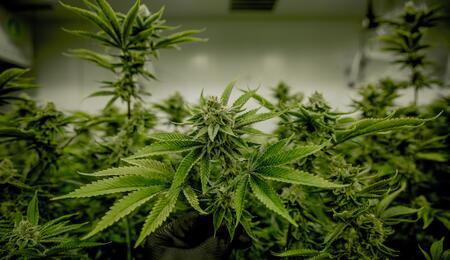Pre-germination: is it reasonable or not?

Many growers are in favour of the pre-germination of seeds, as this allows them to forecast if they are germinable or not. Pre-germinated seeds are placed in pots after 4 to 5 days with some potting compost, when seed leaves (cotyledons) open and need light. In this respect, you should also be aware that, if seeds are wrongly sowed, pre-germination will also go wrong.
It seems illogical to hear growers say they could simply throw their seeds in a glass of water and that would be just fine. Unless it is just a matter of marsh plants and aquatic plants, roots should take air and much more nutrients than can be found in water. In the past, pre-germination in damp kitchen paper towels kept between two dishes seemed unnecessary, and therefore the common practice was always sowing. To understand whether pre-germination is better, or how to make it, you can try it both in a glass of water and on kitchen paper kept between two dishes in a dark environment with both normal running water and distilled water.
First of all, it is worth clarifying if results strongly depend on the type of running water used and if special additives could also be used. Possibly this test is representative not only for each type of running water, but also for distilled water without additives. We used a type of running water that is normal for German growing environments, in addition there was a temperature of above 20° Celsius in the room, although the critical temperature threshold of above 24 degrees was not exceeded. Had it been colder, the process would have lasted longer. In our experiment, the first seeds were planted after about three days. We also used industrial hemp. There was no intention to grow hemp, but just to take pictures of it. All germinated seeds were destroyed. This information is important as in edible hemp seeds, no germination rate of above 90% is expected, and it could be even below 40%. The key rationale of tests of this type is to only identify seeds that are good to do something rather than using all seeds together, if you cannot do absolutely anything with all of them, which however was not the case in our test.
seeds of hemp grown for fibre - on the left, grown on kitchen paper; on the right, grown in water
first two days in water, then on kitchen paper
cuticles on the seedling on the left, no more on the right
pre-germination with distilled water
The actual tests:
Three tests were conducted: with running water, with distilled water and finally again with running water but in this case the first two days in a glass and, next, 50% of the seeds were placed in a damp kitchen paper towel. All of the three tests produced the same results: In the glass of water it is no use to change water every day. The turbidity that appears after two days, attributable to bacteria, disappears later, but seeds in water stopped developing, whereas on damp kitchen paper their development was already advanced. This prompted me to take away seeds from the glass of water after two days and place them in the damp kitchen paper between two dishes. In all three tests the intact part of the seeds developed in the damp kitchen paper between the two dishes with the same results: After three to five days, the germinated seedlings need to be planted, as the opened cotyledons need light, but the roots should not be exposed to it.
A first group of seeds were dropped in a glass of water while others in a china cup with water, obviously in a dark room. It was found that water gets burred and milky after two days and that even a daily change of water does not impact on the further development of the seeds. Furthermore the putrid smell, which perhaps brings to mind a sewer, is stronger in the china cup. The smell increases if you remove water and smell seeds. In water bacteria are found while seeds will have nutrients. They will begin to germinate, und an exchange of water takes place.
At the beginning one would tend to be sceptical as the roots projecting from hemp seeds necessarily need oxygen. If this is not available in sufficient concentration, then things would go really bad. The seeds would naturally break after a few days, with a daily water exchange perhaps this lasts two days longer. The only apparent possibility to pre-germinate in water is the use of water additives. Anyway, the problem arose also with distilled water so that, after the first two days of pre-germination, there was no growth of seeds. The highest possible number of additives, which aid germination and deliver oxygen, may turn the test result into positive, this is the assumption. If you wish you could procure the special 3-level germination tower “Schnitzer Sprossenturm – 3 Etagen” from Amazon or elsewhere: the seed is damped, but for a good reason not kept for days in water.
On damp kitchen paper, germinable seeds develop very well. Those who intend to opt for pre-germination should place the seeds on damp kitchen paper between two dishes in a dark environment, control temperature for it not to go neither too high nor too low and dry out the kitchen paper during the germination period.
Minor details about pre-germination:
However, if seeds are simply placed in the soil in dry air conditions and germinate, they can present the following problem: with dry air, the grain of seed does not shred off its coat, and cotyledons cannot open up. There is a cuticle in this coat around the grain of seed and therefore, after germination, around cotyledons. In dry air conditions, cotyledons do not slip off. If you put a drop of water with a pipette on the cuticle or the coat and wait 15 minutes, you can then remove everything with tweezers (but you should be careful). Air humidity of above 60% or pouring a drop on the cotyledon every two hours should also suffice. In nature, this operation is done by morning dews. With pre-germination, before the planting process starts, you should make sure that the coat and, more importantly, the cuticles below are removed. If the cotyledons cannot open, the young shoot will most probably shrink or remain behind. Otherwise said, the shoot can simply roll back on the cotyledons that will stick together, if these are not completely protected from the light.
Try before:
Many growers want to pre-germinate, in order to see if seeds are germinable. If not, they will complain. Replacement could be granted more at the company’s discretion rather than being based on a real right of the customer, as probably there was something wrong in what was done. In order to be sure not to do something wrong, everything should be tested on other seeds, such as industrial hemp seeds or corn seeds. However it is possible for industrial hemp to be processed by the factory in such a way as not to germinate, while this is impossible with corn. If you can, you should always let test seeds pre-germinate separately together with the good seeds, in order to gain evidence that everything was done correctly and that, consequently, a failure is really attributable to the purchased seeds (for which you paid a good deal of money). Another strategy is not to let seeds pre-germinate on a single occasion or to sow only a part of them. If sowing is made correctly, many seeds will soon develop into a plant, as it happens with the correct pre-germination.
Sowing or planting after pre-germination:
A person who starts from scratch and has absolutely no basic knowledge of plant growing, necessarily needs to make a lot of errors and learn from them. A beginner could also receive tips that will only cause more damage than be useful, as, e.g., in the case of pre-germination made in a glass of water. Using, for instance, too much fertiliser for the planting of a grain of seed or an offshoot is very counterproductive, as it prevents the achievement of a higher EC value in the roots. From a given quantity of nutrients above, the root stimulator will no longer help. An exception could be a long-release fertiliser, as it is released little by little, but does not directly affect the EC value on the whole. And still then, for the first three weeks, a high-quality type of non-pre-fertilised potting soil should be used. It is recommended to use pots of 0.25 to 0.5 litres, in order to minimise the use of space in the grow-room initially. In addition, less soil will normally dry out more rapidly, when someone irrigates excessively.
If plants grow bigger they can simply be re-potted; here they need even more nutrients. It is reasonable to do so with potting soil only, in order to ensure that high-quality pre-fertilised soil is used. However, also a non-pre-fertilised type of soil can be used, so that it will be possible to directly pour nutrient solutions. Many say that hemp can be grown with little water and little fertilisers or pesticides in a field. Hemp needs little fertiliser quantities as a few other plants; however, those who want to harvest seeds, marijuana or a lot of biomass, should also feed at least a bit of nutrients to the plant. Otherwise results will be poor.
So, in conclusion, pre-germination or not?
This test is necessary, as formerly people tended to sow rather than pre-germinate. With pre-germination growers can see earlier if a grain of seed “works” or not, but there is not much difference if the sowing process is correctly carried out. It is therefore unimportant that the grain of seed correctly lies in the soil, as the root always grows downwards and pushes the cotyledons upwards. What is rather important is that soil and water are suited and that temperature conditions are favourable. In sowing as in pre-germination the same is true: roots need not only humidity, but also air. You can irrigate the potting soil excessively, wait long, but nothing will probably happen.
Without the necessary air, a grain of corn will rest and, if you later empty the pot onto compost you will see that the grain will sprout. So why not pre-germinate, if it works equally well? Because when roots start to grow perhaps the development of the cotyledons is somewhat interrupted. Pots still not need to be large but, after about four days, they are needed in any case. The fact of needing less space, therefore, should not be a leading argument. Of course, a seed can also undergo damage, if it has to germinate and grow in the pot. From a temperature of 26° C, no result will be obtained with both techniques, everything can be doused with water, or the pot can tip over and damage will appear.
Breathing mask, gloves and sterilisation
Many city people, who perhaps are used to only water their mother’s pot plants, think that everything is complicated and difficult. This also applies to more and more people from rural areas who grow with their playstations in their hands as a usual habit. The pre-germination or sowing of hemp seeds is not complex, if you do it right. Hemp seeds have protection mechanisms to avoid being destroyed when coming into contact with the first bacteria during germination. These bacteria could be in the air, on the grower’s hands, on surfaces, in water and also on sowed soil.
Ordinary people, who grow hemp in normal situations will barely obtain something with breathing masks, gloves or similar protective equipment. Of course one should not use soil from his garden, in which many ‘stowaways’ can be found. High-quality soil needs to be purchased, unless growers are wise enough and have the opportunity to produce some of this type on their own. In addition, a plant that is kept outdoors should not be brought inside where other plants are kept. The issue is then not to let in cats and dogs wandering about outside, and certain plants placed in front of the window for air supply should be taken away, if the incoming air cannot be sufficiently filtered.
A problem to be absolutely avoided is the introduction of pests from the soil, outdoor plants, shoes or pets. However, for pre-germination and sowing in normal conditions, it is sufficient for a grower to operate accurately in a clean environment, as he may not and should not protect everything hermetically. On the other hand, in case of greenhouses, where plants worth millions are grown, the problem can be viewed from a different angle and costly air control systems can be installed so that, once inside, one should not have to wear disposable gloves to grab seeds.
Even after elaborating on the topic of “pre-germination” in theory, in practice you will always have to work with living organisms. Everything will normally work out smoothly, if you operate in very similar general conditions and according to plan. However any surfacing impediments cannot be ruled out and even in “normal” conditions everything may not perfectly work to plan, but much can still be remedied.



